You are using an out of date browser. It may not display this or other websites correctly.
You should upgrade or use an alternative browser.
You should upgrade or use an alternative browser.
Russia UAV programs, News & Update
- Thread starter Cabatli_TR
- Start date
State of Russian electronics is not good. Never really recovered after collapse of Soviet Union. Russia can't work with western companies for many reasons. Sukhoi/HAL FGFA program got cancelled which could gotten investment to recover in some fields. Russia could work with China but that would be bad for image Russia trying to hold.
Last edited:
Is this the same uav ? The TB2 killer according to russian news.
Is this the same uav ? The TB2 killer according to russian news.
LoL, ad air to air missile to TB2 it will be drone killer to.
Russia’s top long-range attack drones
27 Nov 2020Russia is accelerating the development of multiple long-range attack UAVs to compete with the US and China who are ahead in the combat drone race. Army Technology lists the top five of the Russian long-range attack drones under development, based on their technical specifications.

Army Technology lists the top five of the Russian long-range attack drones under development. Image courtesy of Esteban De Armas/Shutterstock.
Share Article
Russia is accelerating the development of multiple long-range attack UAVs to compete with the US and China who are ahead in the combat drone race.Army Technology lists the top five of Russia’s long-range attack drones under development, based on their technical specifications.
Sukhoi S-70 Okhotnik-B (Hunter)

The S-70 Okhotnik-B (Hunter) combat drone made its first flight in August 2019. Image courtesy of TerHussein.
The S-70 Okhotnik-B (Hunter) is a stealth-capable combat drone being developed by Sukhoi Design Bureau and Russian Aircraft Corporation MiG. The drone made its first flight in August 2019. The unmanned combat aerial vehicle (UCAV) is expected to be delivered to the Russian armed forces in 2024.
Anticipated to serve as a ‘loyal wingman’, the stealthy drone incorporates a flying wing design, while its composite fuselage is covered with the radar-absorbing paint. It is designed to offer a lower radar cross-section. Powered by an AL-31 turbojet engine, the UCAV can be installed with electro-optical targeting, communication, and reconnaissance payloads.
With the maximum take-off weight of 20t, the Okhotnik-B combat drone is significantly bigger than its Western counterparts such as Dassault nEUROn and Northrop Grumman X-47B. The length and wingspan of the Hunter UCAV are 14m and 20m, respectively.
The attack drone features two internal weapon bays to accommodate up to 2,000kg of guided and unguided munitions, including air-to-surface missiles and bombs. It is expected to fly at a speed of 1,000km/h and attain a maximum range of 6,000km.
Grom (Thunder)
Grom (Thunder) is a new stealth combat drone designed by Kronstadt. A mock-up of the UAV was presented during the Army-2020 trade show held in Moscow, in August 2020. The Thunder UCAV is intended to operate, along with the Su-35 and Su-57 fighter aircraft, to provide reconnaissance data and fire missiles upon receiving commands from the manned jet.With its dorsal inlet and V-shape tail, Russia’s long-range attack drone bears a striking resemblance to the Kratos XQ-58 Valkyrie stealthy unmanned combat aerial vehicle. The Grom combat UAV measures 13.8m-long and 3.8m-high while its wingspan is 10m.
The drone has a maximum take-off weight of 7t and can carry a maximum payload of 2,000kg. It has four hard-points including two under the wing consoles and two inside the fuselage. It can carry Izdeliye 85, KAB-250-LG-E, KAB-500S-E, and X-38MLE munitions.
The stealthy drone can fly at a cruise speed of 800km/h and reach a maximum altitude of 12,000m. It has a maximum speed of approximately 1,000km/h, while the combat radius of the UAV is 700km.
Altius-U

The Altius-U medium altitude long endurance (MALE) drone can carry 2,000kg of combat payload. Image courtesy of Geektrooper2.
The Altius-U medium altitude long endurance (MALE) drone is being developed by Ural Civil Aviation Plant (UZGA). The attack and reconnaissance capabilities of the drone are believed to be comparable to that of RQ-9 Reaper and RQ-4 Global Hawk UAVs.
The Altius-U MALE UAV made its first flight in August 2019. It flew for 32 minutes at a maximum altitude of 800m in fully autonomous mode. The drone is expected to perform reconnaissance, strike and electronic attack missions for the Russian Air Force and Navy.
The fixed-wing design of the unmanned aerial vehicle incorporates a large high-mounted wing, a V-tail configuration and a three-leg retractable landing gear. Built using the composite materials, Altius is powered by two new VK-800C turboprop engines developed by the Klimov Design Bureau.
The 7t drone can carry 2t of combat payload, including a family of Grom 9-A-7759 gliding bombs which can engage targets at a distance of 120km. The drone can target headquarters, radars, missile and air defence units and land-based cruise missile launchers while supporting low-intensity conflicts and counter-terrorism operations.
Kronstadt Sirius

The Sirius MALE attack UAV was presented at the Army-2020 exhibition held in August 2020. Image courtesy of KVN1777/Shutterstock.
The Sirius medium-altitude long-endurance (MALE) attack UAV from Kronstadt is touted to be the biggest Russian drone with a wingspan of 30m. It is intended to support the surveillance missions at the borders and the Russian exclusive economic zone (EEZ) in the Arctic and the Pacific.
A full-size mock-up of the 5t drone was presented for the first time at the MAKS-2019 International Aviation and Space Salon held at Zhukovsky International Airport near Moscow, Russia. It was also on display at the Army-2020 international military-technical forum held in August 2020.
The long-range reconnaissance and attack drone will have a length of 9m and a height of 3.3m. It will also feature a satellite communications complex, allowing it to perform long-range reconnaissance and combat missions.
The drone will have the capacity to carry a maximum combat load of 450kg, allowing it to carry guided bombs or air-to-ground missiles. It will cruise at a speed of 295km/h and fly at an altitude of 12,000m. The endurance of the Sirius UAV with full payload will be 40 hours.
Kronshtadt Orion

The Orion UAV can carry KAB-50 bombs and UPAB-50S 50kg guided munitions. Image courtesy of Nickel nitride.
Orion is a medium-altitude combat-capable UAV developed by Kronstadt, a part of Sistema JSFC. Kronstadt showcased the Orion drone, along with a full range of weapons, during the Army-2020 defence exhibition held in August 2020.
The fixed-wing design of the Orion drone integrates V-shaped tail fins. The drone is made of carbon plastic composite materials to reduce the weight of fuselage. It is also equipped with an electric impulse anti-icing system for operation in low temperatures.
The drone can carry four guided bombs or four missiles, including the KAB-50 bombs and UPAB-50S 50kg guided munitions. The UPAB-50S missile can strike personnel and objects at a maximum distance of 30km. It can be attached with high-explosive (HE) fragmentation, cluster, and fuel-air explosive warhead types. The combat UAV is also installed with a new weapon guidance system.
The Orion UAV has a maximum speed of 200km/h while its maximum flight duration with the standard payload is 24 hours. Orion-E, the export version, has a maximum take-off weight of 1,000kg and can carry a 200kg payload, including four 50kg or two 100kg munitions.
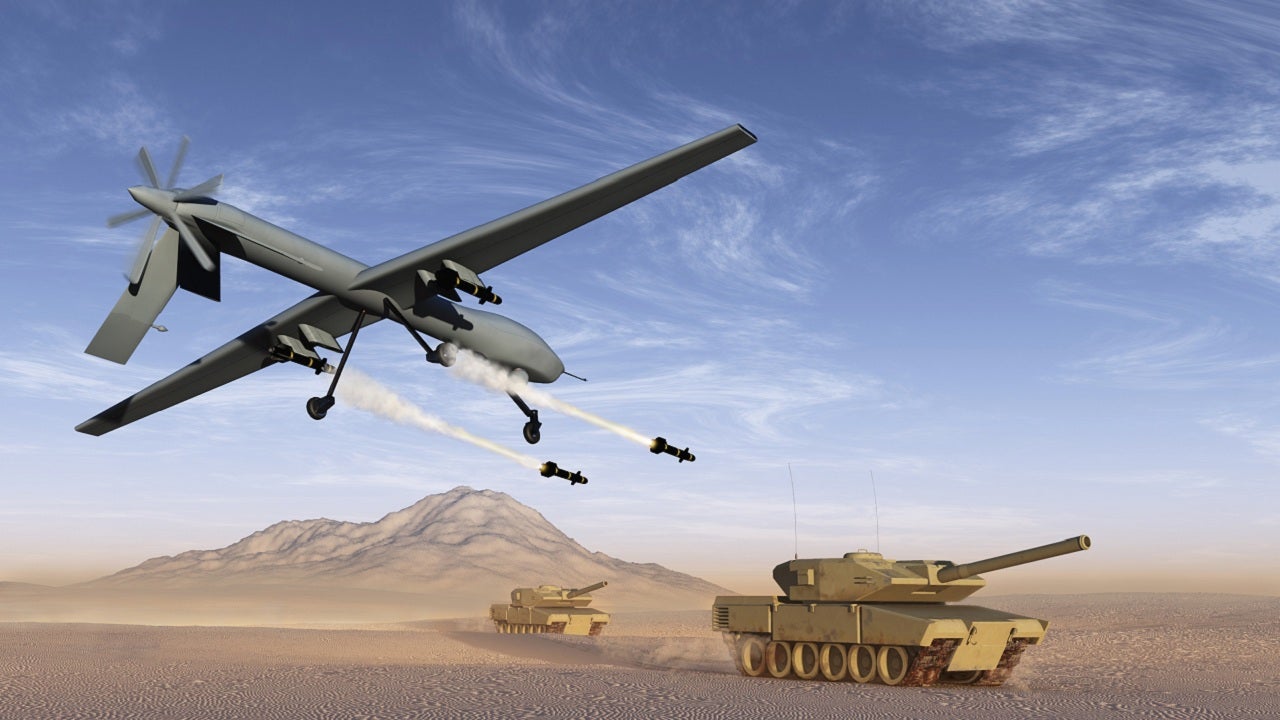
Russia's Top Long-Range Attack Drones: A Comprehensive Overview
Explore Russia's top long-range attack drones with Airforce Technology. Delve into insightful features highlighting the capabilities, specifications.
Article is from 2020, but I thought it's appropriate to have a thread on the topic for Russia.
Russia’s Rapid UAV Expansion
This is an article published in our December 2018/January 2019 Issue.By
David Oliver
-
March 22, 2019
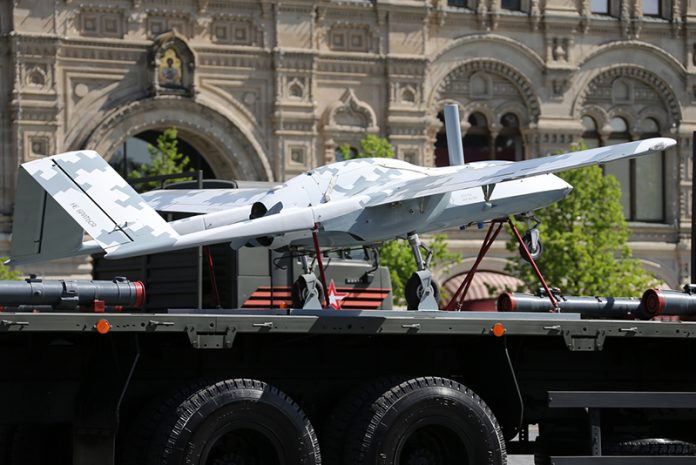
The Luch Design Bureau’s multirole Korsar MALE UAV is entering pro-duction equipped with an electronic warfare (EW) system. (Russian MOD)
David Oliver – In eight year Russia has increased its operational UAV fleet to over 2,000 UAV systems, with new types currently under development.
Since the beginning of the anti-terrorist operation in Syria in September 2015, Russian unmanned aerial vehicles (UAVs) have performed more than 23,000 flights amounting to a total of 140,000 flight hours. Headed by a specialised department of the General Staff of the Russian Armed Forces, commanded by Major General Alexander Novikov, the UAV units have provided round-the-clock monitoring of the ground situation throughout Syrian territory. In addition, Russia claims that the use of unmanned aircraft ensured the effective use of precision weapons on the infrastructure of international terrorists and at the same time excluded possible casualties among the civilian population.
General Novikov has stated that the Russian Army now has some 1,900 UAVs in service and unmanned aviation services have been created in the headquarters of military districts and formations, with UAVs being used in almost all operational and military training activities.
Exercise Vostok 2018 in September 2018 involved more than a quarter of a million troops and included some 1,000 aircraft, helicopters and UAVs. Special tactical exercises involving UAV crews took place at three training grounds in the Leningrad, Voronezh and Moscow regions during which UAV crews gathered intelligence for motorised rifle, tank, artillery units, and escort reconnaissance groups over various terrains. These exercises involved some 500 servicemen and up to 20 unmanned aerial systems (UAS) including Grushas, Eleron, Granat, Orian-10 and Forpost.
The Grusha is a hand-launched short-range mini-UAV produced by the Izhmash JSC, now part of the Kalashnikov Group, which has entered the inventory of Russia’s Baltic Fleet. The Eleron-3 is a short-range tactical tail-less delta UAV with a maximum takeoff weight (MTOW) of 5.3kg carrying a 1kg payload. Manufactured by ENICS JSC it has a speed of 56 knots (104km/h) and operates at a maximum altitude of 13,123 feet (4,000m).

More than 200 Eleron-3 short-range tactical UAVs manufactured by ENICS JSC are in service with the Russian Armed Forces. (Russian MOD)
The Izhmash Granat-4 has a MTOW of 30kg, with a 3kg payload. With a 3.2m wingspan it has a cruising speed of 49kts (90km/h), an operational range of up to 70km, and a maximum flight altitude of 11,500ft (3,500m). The 3.1m wingspan Orian-10 manufactured by the Special Technology Centre is one of Russia’s most prolific UAVs. With a MTOW 16.5kg carrying a 2.5kg payload it has a speed of up to 80kts (150km/hr), a mission radius of 500km and a flight endurance of 16 hours. The Orian-10 is launched by a collapsible catapult and recovered by parachute landing.
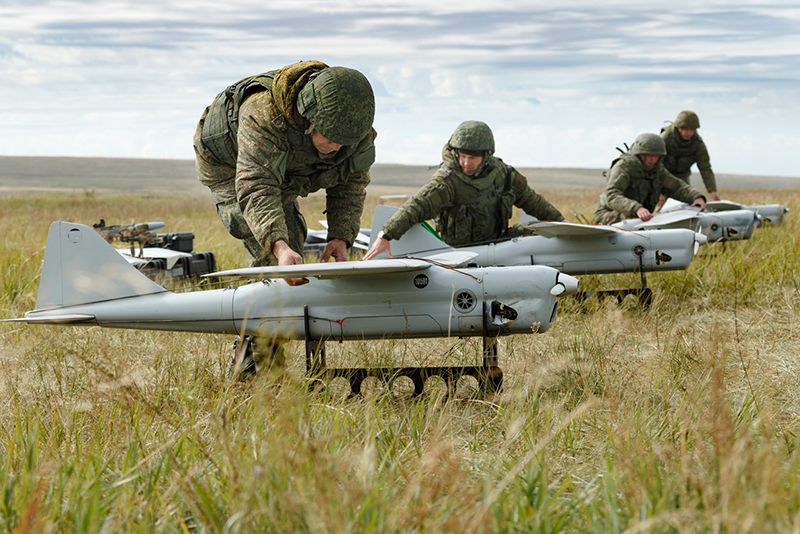
The medium-range Orian-10 UAV has been used operationally in Syria and over the Ukraine. (Russian MOD)
The Forpost is a Russian license-produced version of the Israel Aerospace Industries (IAI) Searcher II long-endurance multirole UAV.
Following collaboration with the Austrian company Schiebel in 2011, the Russian company OAO Gorizont (Horizon) has been building the rotary-wing Schiebel S-100 Camcopter UAV under license for the Russian market. Based in Rostov-on-Don, Horizon manufactures electrical and optical equipment, navigation radar modules and systems and equipment for monitoring land, coastal and marine environments.
During the 2014 Winter Olympic Games and Paralympics, a Horizon Air S-100 operated from Sochi up to 50km from the Black Sea shoreline around the Olympic village. The Russian built S-100 has also been evaluated by the Russian Coast Guard and successfully tested aboard the Russian Rubin-class Maritime Border Patrol vessels being built for patrolling the Black and Caspian seas, with the UAV.
After trials carried out on the icebreaker Captain Sorokin in the Baltic Sea the Horizon Air S-100 was selected to operate from Russia Navy’s new generation icebreaker, Viktor Chernomyrdin.
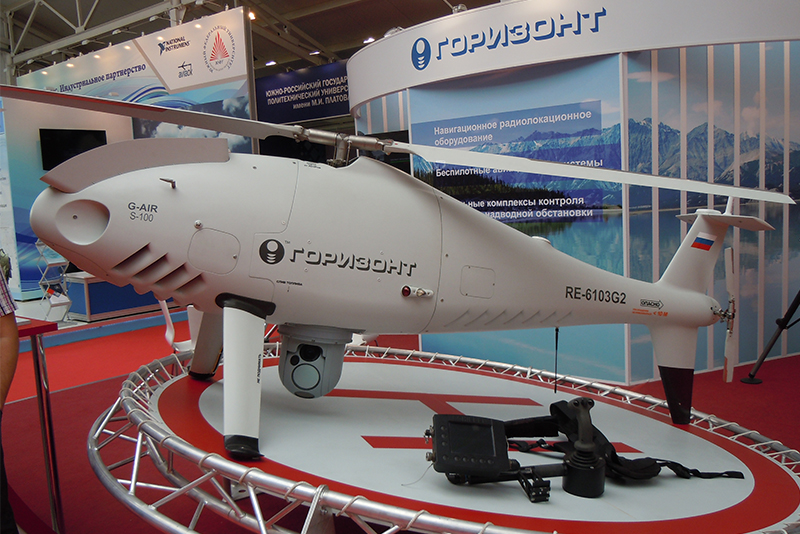
An unmanned VTOL Horizon Air S-100 displayed on a portable helipad has been deployed to Russian Navy icebreakers. (David Oliver)
The research and development company Radar MMS is developing a small unmanned helicopter, the GSV-37 Breeze, for the Russian Navy. The Breeze is designed for monitoring large areas from the air, providing search and rescue, patrol and security, and counter-terrorism support. The MTOW of the UAV is 35kg, and it has an endurance of 90 minutes operating up to 3,280 feet (1,000m).
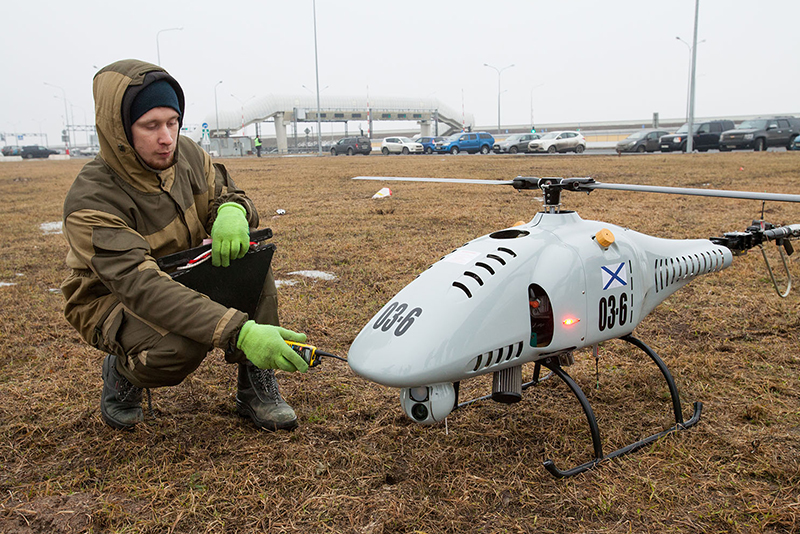
The Radar MMS VTOL GSV-37 Breeze UAV has been evaluated by the Russian Navy. (Radar MMS)
The annual Falcon Hunting international UAV contest was part of the Russian International Army Games 2018 involved teams from Belarus, Iran, Kazakhstan and Russia. This year, the competition held at the Matibulak training ground in Kazakhstan included a new element, air reconnaissance at night over enemy forces. The three-day event culminated in the participants competing to find objects in three reconnaissance districts with the area from nine to 25 square kilometres at a distance from 10 to 35km from starting position of the UAV.
The host team from Kazakhstan team won the 2018 Falcon Hunting contest with Russia in second place and Belorussia in third. A month after the Falcon Hunting competition, forces returned to Kazakhstan in October to participate in the tactical exercise Search 2018 at the Matibulak and Gvardeisky training grounds for Collective Security Treaty Organisation (CSTO) countries,. Troops from Armenia, Belarus, Kazakhstan, Kyrgystan, Russia and Tajikistan took part in the Search 2018 manoeuvres. The Russian forces in the exercise were represented by scout units and special forces (SOF) units of the Central Military District, a total of over 300 troops, supported by two Sukhoi Su-24MR intelligence aircraft, and Orlan-10 and Forpost UAVs.
Lessons from Ukraine
While the Russian Armed Forces’ UAV capability is being rapidly expanded, recent operations of their first generation systems have shown how vulnerable they are to both ground and air attack. Russian Orlan-10s have been actively used against the Ukraine during the armed conflict in the Donbass region although aerial reconnaissance by unmanned aerial vehicles is banned by the Minsk agreements. Ukrainian officials have claimed to have shot down or captured at least ten Orlan-10s and two Forpost UAVs since 2014. In October 2018 a Russian Orlan-10 was reported to have been brought down by a Mi-24 helicopter operated by Ukrainian Air Force, over city of Lysychansk in Ukraine.Russia’s priority is now to develop a new generation of medium altitude long-endurance (MALE), high-altitude long-endurance (HALE) and armed unmanned aerial systems.
The Korsar UAV being developed by the Rybinsk-based Luch Design Bureau, part of Ruselectronics Group, was first shown in public during the 2018 Victory Day Parade in Moscow. Powered by a piston engine with a pusher propeller, the 6.5m wingspan 200kg Korsar has a maximum speed of 80kts (150km/h) and 120km mission radius.
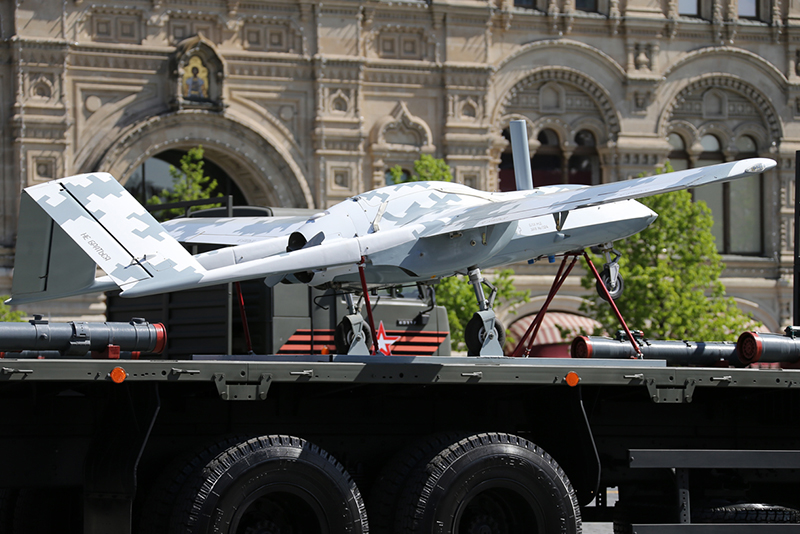
The Luch Design Bureau’s multirole Korsar MALE UAV is entering pro-duction equipped with an electronic warfare (EW) system. (Russian MOD)
In September 2018 the Kronshtadt Group, a subsidiary of Joint-Stock Financial Corporation Sistema, unveiled a strike-capable variant of the Orion-E MALE UAV. With a wingspan of 16m and an MTOW of 1,000kg the Orion-E is capable of automatic take-off and landing carrying surveillance payloads of up to 200kg. It has service ceiling of 24,500 feet (7,500m), a range of 250km and an endurance of 24 hours.
The Reaper-class air vehicle has an electro-optical/infrared (EO/IR) turret as well as a laser rangefinder/target designator. Additional sensors, including an electronic intelligence system, high-resolution photo camera, or a radar can be carried as well a variety of guided and unguided air-to-ground weapons. The air vehicle can be disassembled and transported along with its technical support systems and ground control station (GCS) in a standard cargo container.
The Kronshtadt Group is also developing an even more advanced version of the Orion-E designated Orion-2 that will be the first HALE UAV in the company’s portfolio. The air vehicle is understood to have a MTOW of 5,000kg, a maximum flight altitude of nearly 40,000 feet (12,000m) and a speed of 189kts (350km/h).
The Russian Navy also has a requirement for ship-based unmanned aerial systems (UAS) which is being addressed by a number of advanced UAV projects. The Fazan is a vertical take-off and landing (VTOL) tail sitting air vehicle to fulfil a number of urgent military tasks including reconnaissance and surveillance, in particular, during the operations from ship’s deck, as well as vertical replenishment (VERTREP) missions. The MTOW of the Fazan will be up to 500kg with a 60kg payload. The cruising speed is predicted to about 189kts (350km/h), a range of 1,000km and an endurance of six hours.
The Russian Navy Commander-in-Chief’s directorate has revealed that a modular UAS is being developed for its Project 22160 corvettes and is now being prepared for trials. The UAS includes two co-axial Radar MMS BPV-500 VTOL UAVs. With an MTOW 500kg the 5m-long air vehicle can carry a 150kg payload over a range of 320km and 5.5 hour endurance.
Equipped with an optronic sensor system and SAR/MTI radar, the system is designed for aerial monitoring of large areas, including for on-ice reconnaissance, support of search and rescue operations, surveillance and anti-terrorist missions. Over time, UAVs may be armed with missiles and bombs, which will enable them to perform combat duties. The BPV-500’s co-axial design ensures high hovering accuracy, making it less vulnerable to cross winds which is essential in landing on to a small ship. The air vehicles and their equipment including the operator’s workstation, can be accommodated in one or two standard cargo containers placed on deck of a ship.
In the last five years Russia has also made huge leaps in unmanned technologies. In 2011 Russia possessed only 180 UAV systems. That figure now stands at 2,000. The majority of those platforms have been assigned to land and airborne forces with capabilities limited to intelligence, surveillance and reconnaissance. Russia’s armed forces currently have no armed UAV capability although over $10 billion (€9bn) has been earmarked for combat UAV programmes by 2020.
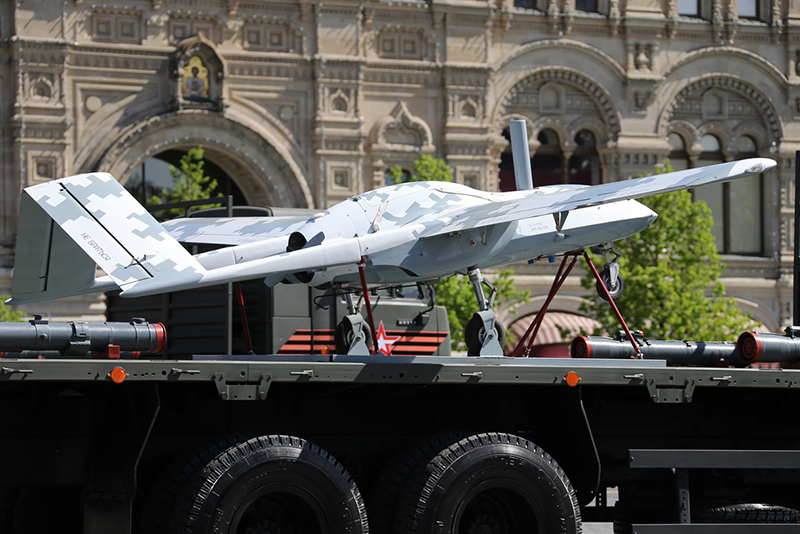
Russia's Rapid UAV Expansion - Armada International
Russia has taken to UAV operations in a big way - with a huge expansion in systems. David Oliver reports for Armada International.
Orlan-10 Unmanned Aerial Vehicle (UAV)
Orlan-10 is a medium-range, multi-purpose unmanned aerial vehicle (UAV) developed by Russian firm Special Technology Center LLC (ООО Специальный Технологический Центр) in St Petersburg. The UAV is in service with the Ministry of Defence of the Russian Federation.Project Type
Unmanned aerial vehicle
Operator
Russian Armed Forces
Wingspan
3.1m
Maximum Take-off Weight
16.5kg
Expand
Share Article

The Orlan-10 unmanned aerial vehicle is operational with the Russian Armed Forces.

The Orlan-10 UAV is launched using a catapult.

The Orlan-10 can fly at a maximum speed of 150km/h.
Orlan-10 is a medium-range, multi-purpose unmanned aerial vehicle (UAV) developed by Russian firm Special Technology Center LLC (ООО Специальный Технологический Центр) in St Petersburg. The UAV is in service with the Ministry of Defence of the Russian Federation.
It is intended for a variety of missions including aerial reconnaissance, observation, monitoring, search and rescue, combat training, jamming, detection of radio signals, and target tracking in hard-to-reach terrains.
The export variant, designated Orlan-10E, was exhibited at the 19th International Air and Space Fair (FIDAE) held in March 2016. Rosoboronexport announced its plans to promote the Orlan-10E UAV to foreign countries in June 2016.
Orders and deliveries
Production on the UAV was commenced in 2010. The unmanned aviation unit of Russian military base located in Armenia received Orlan-10 aerial systems in October 2015, to perform aerial reconnaissance in high-mountain areas.
The Eastern Military District of the Russian Armed Forces, located in Sakhalin, Russia, took delivery of five Orlan-10 unmanned aerial vehicles in March 2016. The UAV is also operational with the Eastern Military District in Chukotka, as well as the Black Sea Fleet.
A batch of unmanned aerial vehicles entered service with the motorised rifle unit of the Eastern Military District, stationed in the Trans-Baikal Territory, in December 2019.
The UAV entered service with the motorised riflemen of the Southern Military District (YuVO) in the North Caucasus in July 2020. The mountain motorised rifle brigade of the Central Military District, stationed in the Republic of Tyva, took delivery of the UAV in December same year.
In October 2020, Divisions of the mountain motorised rifle brigade of the Central Military District (CMD), based in the Republic of Tuva, received Orlan-10 UAVs under the state defence order.
Orlan-10 UAV design and features
The Orlan-10 complex consists of unmanned aerial vehicles, launch and recovery systems, ground control segment, and swappable payloads.
The UAV features modular design with high-wing configuration, while its tail section comprises a tailplane and a vertical stabiliser.
It has a wing span of 3.1m and its aerodynamic fuselage is 2m-long. The empty weight and maximum take-off weights of the UAV are 12.5kg and 16.5kg respectively.
The drone is launched using a collapsible catapult and recovered using parachute landing system.
Payloads carried on Orlan-10 unmanned aerial vehicle
The UAV’s modular design is provided with several interchangeable payloads allowing for greater mission flexibility.
It carries a day-light camera, a thermal imaging camera, a video camera and a radio transmitter in a gyro-stabilised camera pod that is fitted under the fuselage. The cameras provide real-time intelligence, 3D maps, surveillance, and aerial reconnaissance of ground-based targets.
The imagery, video and other sensor data collected by the payloads is transmitted to the ground control station in real-time, through a data link using 3G/4G cellular networks.
The Orlan-10 is fitted with electronic warfare capability and can differentiate between friendly and enemy means of transmitting of information. It can mount interference transmitters and set up zones for cellular jamming.
Command and control modes
The Orlan-10 can execute missions in both autonomous and remote control modes. An autopilot aboard the drone enables it to operate autonomously based on pre-defined waypoints. In this mode, the flight path can be modified by the operator during the flight.
The drone can be remotely operated by its associated ground control station, installed on MP32M1 command and control vehicle. Developed by Russian state-owned Roselectronika, the ground segment can control up to four aerial vehicles simultaneously.
In the remote control mode, operator at the mobile ground segment sends command and control data to the drone through the digital data link.
Orlan-10 UAV propulsion and performance
The Orlan-10 is powered by an internal combustion engine, driving a two-blade propeller mounted in the nose.
The drone can transmit telemetry data to a range between 120km and 600km from the launch station and endure for approximately 18 hours. Its cruising and maximum speeds are 110km/h and 150km/h respectively.
The UAV can fly at a maximum altitude of 5km in all weather conditions in difficult terrains. It can withstand wind speeds of 10m/s and operate in temperatures ranging from -30°C to 40°C.
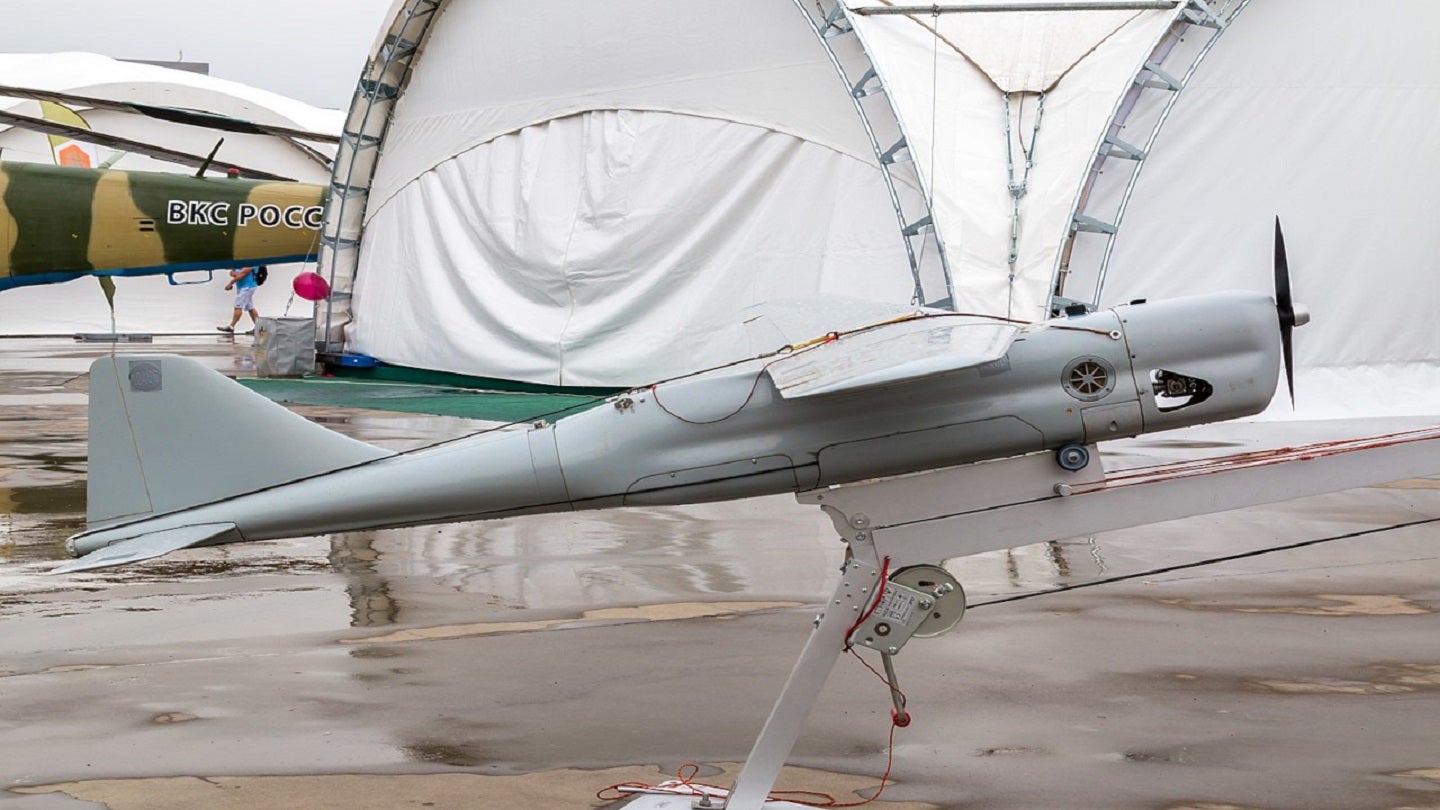
Orlan-10 Uncrewed Aerial Vehicle (UAV) - Airforce Technology
The Orlan-10 is a medium-range, multi-purpose uncrewed aerial vehicle (UAV) developed by Russian firm Special Technology Center LLC (ООО Специальный…
Russian Drone Attack
- Aishwarya Rakesh
- Saturday, September 5, 2020 @ 07:56 AM
- 23975
Orion MALE attack-reconnaissance drone at Army-2020 expo
After lagging behind major drone powers such as the United States, Israel and China, Russia is attempting to challenge, if not forge ahead of some of its competitors. Russian companies displayed several drones - both for attack and reconnaissance / surveillance at the Army-2020 Forum in Moscow whose features match if not exceed that of competing drones from international manufacturers.
We present a sample of these new Russian drones to see if they can find a market beyond the Russian armed forces.
Unmanned aircraft nowadays come equipped with several state-of-the-art technologies; namely, cloud computing-based services, multi-sensor data fusion for UAV navigation, and artificial intelligence (AI). While advanced jets cost a bomb, drones are generally more economical. Effectiveness in active battle zones such as Syria and Libya, where drones have destroyed tanks and brought down fighter jet, have turned focus on them.
In Syria and Libya, Chinese and Turkish drones hogged the limelight due to their lethal attacks on largely Russian air defence systems which are primarily designed as defence against fighter jets. Their relatively low cost, lethality and expendability has made them the first choice of armies as well as militia groups.
A report published by Fortune Business Insights earlier this year projects Military Drone Market size is projected to reach $21.76 billion by 2026 at a Compound annual growth rate (CAGR) of 12.4% during the forecast period. However, it stood at $7.93 billion in 2018.
China currently holds a lion’s share in world drone exports. Stockholm International Peace Research Institute (SIPRI) stated in a report last year that China recorded an overall increase of 1430% growth between 2014 and 2018 in combat drone sales pushing it to the number one spot. Other countries that are doing well in the drone exports race are United States, Turkey and Israel.
While being at the receiving end of drone attacks, Russian designers have developed drone attack and reconnaissance systems based on real battle experiences.
Going by the variety and technology of Russian drones displayed at the Army 2020 Forum held in August, it can rightly be said that the new drones taking off from Moscow that look promising enough for military buyers to take notice.
We sample a few of the promising drones and what they can do.
Attack drones
Orion
At the Army-2020 expo, privately held company, Kronstadt presented the Orion heavy UAV with a full set of weapons. Orion can carry four guided bombs or four missiles and has maximum payload of 200 kg. One of the munitions is the 50-kg guided UPAB-50S is intended for destroying personnel and equipment at up to 30 km ranges. The warhead types could be of HE fragmentation, cluster, fuel-air explosive types. New weapon guidance system has been installed and tested on the Orion, says Kronstadt.
The Orion drone has a service ceiling of 7.5 km and its maximum flight duration with the standard payload is 24 hours. The drone can fly at speeds of up 200kmph. With its maximum take-off weight of 1,000 kg, the Orion-E can carry a 200 kg payload of four 50-kg or two 100-kg munitions.
The updated Orion compares with America’s MQ-1 Predator drone built by General Atomics.
In its reconnaissance-only version designated Orion-E, the drone is intended for day-and-night aerial ISR missions, says the official promotional paper of Kronstadt. Orion-E is capable of performing aerial intelligence, reconnaissance and surveillance; target detection and tracking; aerial mapping; strike damage assessment; radar survey; SIGINT/COMINT. The EO/IR system implements ground targets search and detection in infrared and visible spectrum.

Thunder combat drone (image: Kronshtadt)
Thunder (Grom in Russian)
The stealthy Thunder can attain speeds of about 1,000kmph. Weighing 7 tons, the drone has a payload of 2,000kg. The drone can carry 100kg, 250kg and 500kg bombs. It has four suspension points - two under the wing consoles and two inside the fuselage. Combat radius of the drone is 700km and it can reach altitude of 12,000 meters. Height and wingspan of the drone is 3.8 meters and 10 meters respectively.
The Thunder is intended to function as a ‘loyal wingman’ to the Su-57 E flying alongside the stealth jet at speeds of up to 800 kmph, provide reconnaissance data and fire missiles at a command form the manned jet.
“The Thunder is designed to support Su-35 and Su-57 fighter jets,” Nikolai Dolzhenkov, general designer of the aircraft development company, Kronshtadt, told reporters during Army-2020 on August 24.
Okhotnik (Sukhoi S-70 Hunter)
Okhotnik is a stealth-capable heavy drone that has a low signature, a flying wing design, and a take-off weight of 20 tons. It is made of composite materials and a radar-absorbing coat. The aircraft is powered by an AL-31 turbojet engine and is being outfitted with electro-optical targeting, radio, and “other types of reconnaissance equipment.”
The Sukhoi S-70 Hunter is way larger than its Western counterparts like Dassault nEUROn and Northrop Grumman X-47B. With 20 meters in wingspan and a length of 14 meters, its mass is supposedly around 20 tons (against 4.9 for the Dassault nEUROn and 6.3 for the Northrop Grumman X-47B). In fact, tipping the scales at 20 tons, Okhotnik is about as heavy as a two-engine American F-15 Eagle fighter.
It is expected to fly at a speed of 1,000 kmph, for a range of 6,000 km and its two internal bays should embark up to 2.8 tons of weapons.
It took off on its maiden flight that lasted over 20 minutes on August 3, 2019. In the following month, the Okhotnik performed a flight together with a Su-57 fifth-generation fighter jet. The drone manoeuvred in the air in the automated mode at an altitude of around 1,600 meters and its flight lasted over 30 minutes.
Artillery fire and bomb guidance drone
Orlan-30
The Russian army is expected to receive the latest Orlan-30 drone in 2020, which is a quick-deployable battlefield support system. It has been tested in Syria and at the Center-2019 strategic manoeuvres. Orlan-30 can reconnoitre targets and provide exact coordinates by GLONASS and GPS space navigation systems. The Orlan-30 uses laser illumination for fire with smart ar6-0-artillery shells and for guiding precision air bombs.
Russian UAV expert Anton Lavrov believes. "Laser illumination of the targets will provide sniper accuracy to artillery. Orlan-30 will interact with heavy artillery, e.g. Tyulpan 240mm mortars with Smelchak guided mines. 152mm artillery weapons fire Krasnopol shells. Their flight at the final stage is adjusted by laser marks on the target," he was quoted as saying by Izvestiya last October.
The new vehicle resembles its predecessor Orlan-10. However, its launch weight is close to 30 kg which is twice as big as Orlan-10 has. The drone can fly to a distance of 300 km from the control post at a cruising speed of 150 kmph. Flight duration exceeds five hours. The characteristics allow effective engagement far behind the frontline.
The modular architecture allows changing the payload and onboard equipment. The drone is launched by a catapult which needs small sites and saves fuel.
Orlan-30 can operate with Krasnopol 152mm smart projectiles fired by self-propelled Acacia and Msta-S artillery guns.
Su-57 and Okhotnik flight
Reconnaissance and Surveillance
Sirius
Russia had unveiled its biggest ever drone yet- the 30 meters wingspan -surveillance drone named Sirus during MAKS-2019, that puts in the league of the US-made MQ-9A Global Hawk. To put the drone’s size in perspective, the Boeing 737-800 has a wingspan of 35.8 meters while the larger Global Hawk’s wingspan is 39.63 meters.
The drone has length of 13 meters with a maximum take-off weight of 5 tons and maximum payload of 1 ton. Its cruising speed will be 295 kmph and endurance of 40 hours with full payload.
Its service ceiling is 12000 meters making it a true long range high altitude drone. Its mission profile is aerial patrolling over large swathes of sea, aerial inspection of immense territory, long haul emergency and even express delivery of cargo, information released by Kronstadt said.
It will be powered by turbojet engine most likely derived from current Russian high performance engines.
The payload options for the drone could include infrared thermal and electro-optical. The drone will be connected to ground control by a secure data link and will have self-destruct capability should its controls be seized by the enemy.
Cyclocopter
The Cyclocopter drone was unveiled during Army-2020 Forum. It reportedly features better maneuverability, considerably smaller dimensions and shielded rotors, which helps the vehicle operate close to buildings and other obstacles. Tests of the unmanned aircraft, capable of vertical take-off and landing, were concluded recently. The project to develop a vertical lift and landing drone with cycloidal rotors was approved in late 2018.
Helios
This drone is equipped to handle radar surveillance and assist in guidance. The Helios is a five-tonne radar surveillance and guidance drone. When used as radar, it will most likely be fitted with part of the radar station used in the Beriev A-100 ‘Premier’ early warning and control aircraft.
Altius-U
The Altius-U medium altitude long endurance (MALE) with endurance of 24 hours is capable of performing an entire spectrum of reconnaissance missions using optical, radio engineering and radar.
The Russian drone made its debut flight in August 2019. The flight took place for 32 minutes at an altitude of up to 800m in fully automatic mode at one of the test aerodromes. The MoD posted a video of the maiden flight of a 6-tonne Altius-U drone.
Sirius unmanned aircraft (image: Kronshtadt)
Korsar
Korsar high altitude reconnaissance drone system, can operate from heights in excess of 5000 meters. It was first demonstrated for the first time at the Army 2019 forum.
The Korsar system has been developed by Lutch Design Bureau (part of Ruselectronics) has a flight range of at least 100 km, flight speed of 100 to 180 kmph, and continuous flight duration of at least 7.5 hours.
The working height of the UAV flight is 100 to 4000 meters. The take-off mass is 200 kg, it has a wingspan is 6.5 meters, and fuselage length of 4 meters. Korsar can be equipped with optical electronic systems, a radar station, a digital aerial camera, meteorological equipment, and a cargo unit.
The Korsar project encompassed creating innovative power generation systems, a small-sized engine starting system, and an electronic controller for the power unit of the unmanned aerial vehicle. Its advantage is the network-centric principle of information network organization, used by the developers to facilitate the connection of the UAV to the control center and other parties. The communication system implemented on the drone links to other air and ground objects to form a secure network, which transmits information to the recipient with no delay or loss.
ZALA 421-16EV
ZALA Aero, an Izhevsk-based UAV developer and subsidiary of Kalashnikov Concern, presented its own unique drone complex at ARMY-2020. The drone, known as the ZALA 421-16EV, features a tiltrotor design enabling for vertical take-off and landing.
The platform is said to be ideal for missions including surveillance and aerial photography in difficult-to-reach areas, as it doesn’t require a runway. The drone is said to have a cruising speed of up to 110 kmph, an airborne time of 2 hours, an onboard computer for the recording and streaming of multiple channels of Full HD video, and automatic target tracking, along with an encrypted hard drive.
Leading Russian Drones’ Specifications
| Specifications | Orion | Thunder | Okhotnik | Sirius | Orlan-30 |
| Measurements- Height, Wingspan, Length | - | 3.8m, 10m, 13.8m | Xm, 20m, 14m | Xm, 30m, 13m | |
| Service Ceiling | 7.5 km | - | - | 12 km | 5 km |
| Payload | 200 kg | 2,000 kg | 2800 kg | 1,000 kg | 7kg |
| Max Speed | 200 kmph | 1,000 kmph | 1,000 kmph | 295 kmph | 170 kmph |
| Max Take-off Weight | 1 ton | Weight: 7 tons | 20 tons | 5 tons | 30kg |
| Altitude | 7.5 km | 12,000 m | 600 m in maiden flight | - | |
| Endurance | 24 hours | - | - | 40 hours | 5 hours |
| Unique features | Can Collaborate with SU-35, Su-57 Jets | “Loyal Wingman” to Su-57 Stealth Jet | Laser aimer to illuminate targets |
https://www.defenseworld.net/feature/43/Russian_Drone_Attack#.YaiS9dDMKUk
Last edited:
Kalashnikov to adapt Vikhr-1 antitank missile to Kronstadt company drone by yearend
Defense News August 2021 Global Security army industryPOSTED ON TUESDAY, 24 AUGUST 2021 11:08The Kalashnikov Group integrated into Russia’s Rostec state hi-tech corporation will adapt the Vikhr-1 antitank missile to a long-range drone of the Kronstadt company by the yearend, Group First Deputy CEO Andrei Semyonov said at the Army 2021 international military and technical forum.
Follow Army Recognition on Google News at this link

Four 9K121 Vikhr antitank missiles on helicopter (Picture source: Wikipedia)
"The issue regarding unmanned aerial vehicles is very relevant. The Kalashnikov Group is cooperating with the Kronstadt Company to mount the Vikhr-1 missile on a long-range drone. The work will be completed this year," Semyonov said.
The Vikhr-1, an updated version of the 9K121 Vikhr, was for the first time displayed at the Army 2020 forum. It destroys targets at a distance of 10 km (6.2 mi) and develops a speed of over 600 m/sec. The tandem cumulative warhead pierces 750mm thick homogenous armor behind explosive reactive armor.
The 9K121 Vikhr (Whirlwind; NATO reporting name: AT-16 Scallion) is a laser-guided anti-tank missile. "9K121" is the GRAU designation for the missile system. The missile can be launched from warships, Ka-50 and Ka-52 helicopters, and Su-25T aircraft. It was first shown publicly at the 1992 Farnborough Airshow. The Vikhr-1 missile is part of the Vikhr-M system, which also includes an automatic sight and a depressible launcher. Adopted in 1990. The missile was upgraded in 2021.
The missile is designed to engage vital ground targets, including armoured targets fitted out with built-in and add-on explosive reactive armor, at a range of up to 8 km when fired from a helicopter and 10 km when fired from a fixed-wing aircraft in daytime and up to 5 km at night, as well as air targets in conditions of air defense assets activity.
The automatic sight is provided with TV and IR channels for target sighting, a laser beam channel for missile control, a laser rangefinder, an automatic target tracking unit, a digital computer and a system for stabilization and aiming the sighting and beam channels. The automatic sight provides for target detection and identification both by day and night, automatic target tracking and missile guidance, and generates exact information for gun and rocket firing. The guided missile consists of a HEAT fragmentation warhead fitted with a contact and a proximity fuze, an air-dynamic control actuator, control electronics, a motor and laser detector. It is kept in a sealed launching transporting container.
The multi-purpose warhead (two-stage HEAT and an additional fragmentation sleeve) allows the missile to be used against armoured, airborne and area targets alike. This is an advantage compared to the three different missiles required in the 9M120 Ataka-V complex. The use of the proximity fuze allows a near miss of up to 5 m and makes it possible to engage an air target at speeds of 500 m/s.
The Vikhr missile laser beam control system provides for its precise guidance owing to data transmission to the missile in the course of its launch, which is excluded in homing systems. The laser guidance principle is identical to that used by 9M117 Bastion or 9M119 Svir antiarmor missiles. The Vikhr missile control system has high jamming immunity because its receiver faces the carrier, thereby protecting it from jamming signals.
The high pinpoint target hit probability (reported 0.95 against stationary targets) is provided by the automatic target tracking system and highly accurate missile control system that makes allowance for changes in the parameters of the carrier and the target in the course of firing.
The missiles can be fired singly or in pairs (at the same target to increase lethality). The high flight speed allows it to engage targets rapidly. The system is capable of launching Vikhr missiles against two to four targets during a 30-second period and starting at a range of 10 km, which increases its lethality to three to four times that of earlier systems.

Kalashnikov to adapt Vikhr-1 antitank missile to Kronstadt company dro
The Kalashnikov Group integrated into Russia’s Rostec state hi-tech corporation will adapt the Vikhr-1 antitank missile to a long-range drone of the Kronst
@Cabatli_53 Can we sticky this thread. I'll go through RU section and report/request merging articles with this thread and hopefully it'll give people a go-to place to read up on Russian UAV 
MOSCOW — The first flight-ready model of Russia’s upgraded S-70 Okhotnik (Hunter) heavy combat drone is on its way to the military for testing, with fielding expected in 2024.
Developed by Chkalov’s Novosibirsk aviation plant in western Siberia — a subsidiary of aircraft specialist Sukhoi Company — the drone is equipped with a flat nozzle to increase its stealth capability. It has a takeoff weight of 20 tons, measures 14 meters long and has a wingspan of 19 meters.
Reports claim the new version can reach speeds up to 1,000 kph.
The new S-70 is equipped with technologies “surpassing a few foreign analogues by a number of parameters,” Russian Deputy Defence Minister Alexey Krivoruchko told reporters Wednesday during a visit to the Novosibirsk plant.

 www.defensenews.com
www.defensenews.com
Developed by Chkalov’s Novosibirsk aviation plant in western Siberia — a subsidiary of aircraft specialist Sukhoi Company — the drone is equipped with a flat nozzle to increase its stealth capability. It has a takeoff weight of 20 tons, measures 14 meters long and has a wingspan of 19 meters.
Reports claim the new version can reach speeds up to 1,000 kph.
The new S-70 is equipped with technologies “surpassing a few foreign analogues by a number of parameters,” Russian Deputy Defence Minister Alexey Krivoruchko told reporters Wednesday during a visit to the Novosibirsk plant.

Russia unveils upgraded S-70 Hunter drone, with plans for fielding in 2024
Developed by Chkalov’s Novosibirsk aviation plant in western Siberia, the drone is equipped with a flat nozzle to increase its stealth capability.
Footage of the combat operation of the Orlan-10 UAV was shown by the Russian Defense Ministry. The Orlan-10 UAV began to be delivered to the troops in 2010 and by now is the most massive UAV of the Russian army used in Ukraine. The Orlan-10 has a mass of 14 kg and is capable of carrying up to 4 high-explosive shells. In various configurations, UAVs can conduct surveillance in the optical and infrared range. Orlan‑10 is capable of automatically detecting the positions of switched-on GSM phones, VHF communication stations, operating radars. And the compact electronic warfare systems on board allow this device to jam GSM communications and disrupt the operation of GPS receivers.. One of the main features of the Orlan‑10 UAV is integration with the Msta ACS, it was these drones that provided laser illumination of targets for the Krasnopol corrected projectiles fired by the Msta‑S artillery installations. The device is collapsible and fits into a container. The UAV is equipped with a gasoline engine, with which it develops speeds up to 130-150 km / h. The duration of the flight is 15-16 hours . The launch of the UAV is carried out from the catapult installation. The flight takes place automatically according to a pre-programmed program or under the control of an operator. Landing is performed using a parachute and a balloon under the bottom. Flight range, 600 kilometers, range 120. The price of the Orlan-10 UAV is from 87,000 to 120,000 dollars.
M
Manomed
Guest
worse drone ever made to this day
The Russian militia conducted real tests in Ukraine of the Russian gun against LPD-801 drones from the PPSh Laboratory company. Judging by the results, the anti-drone gun really works on most popular commercial drones. The gun suppresses communication channels and data transmission from the UAV, and also suppresses navigation channels. The effective range of suppressing drones is up to 1 km, the gun is on sale, the cost at the moment is $ 19,500.
Russia has begun using the new Lastochka-M attack drones in Ukraine. There is no information on the new UAV. It is assumed that the drone "Swallow" is an analogue of the Skylark-1 LE made in Israel. It is only known that the "Swallows" in the course of combat use fragmentation and cumulative ammunition and they were struck by armored vehicles and manpower of the enemy. The drone is launched from a catapult and lands on an airbag. The UAV drops small-caliber ammunition adapted for use from the air. If we assume that this is a modernization of the Israeli Skylark-1 drone, then the characteristics of the Lastochka UAV will be something like this. Take-off weight 7.5 kg, payload 1.2 kg, operating time up to 3 hours, flight distance up to 40 km, application altitude up to 5000 meters. The drone uses 43 mm grenades adapted for air strikes.








